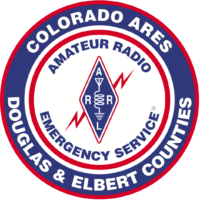Weather spotting is the act of observing weather for the purpose of monitoring storms in the local area and reporting real-time conditions to a larger group or organization. ARES R1D5 participates in weather spotting activities and reports observations to SkyView Weather. Colorado ARES (COARES) has a working relationship with Skywarn and the Nation Weather Service (NWS) in Boulder, CO. The NWS uses SkyView Weather to interface with ARES. It is important to note that ARES R1D5 does not “chase” but instead “spots.” Spotters stay close to where they live and report local weather conditions. Chasers typically drive many miles to hunt down storms in areas they may not be familiar with in the deliberate pursuit of severe weather phenomenon to experience, study, and/or capture the event.
On Thursday, March 16th, 2023, R1D5 hosted a National Weather Service SKYWARN spotter training event in Highlands Ranch. Greg Heavener from the NWS provided SKYWARN training to help refresh R1D5’s experienced members with weather features they don’t see every day and to provide training and a spotter number to newer members. Training topics included the basics of thunderstorm development, fundamentals of storm structure, identifying potential severe weather features, how to report information, and basic severe weather safety. According to NWS’s website, “To obtain critical weather information, the National Weather Service (NWS) established SKYWARN® with partner organizations. SKYWARN® is a volunteer program with between 350,000 and 400,000 trained severe weather spotters. These volunteers help keep their local communities safe by providing timely and accurate reports of severe weather to the National Weather Service.”
On Thursday, March 23rd, 2023, R1D5 member Jim Rooney (N4JJR) supplemented the previous week’s training by reviewing how R1D5 activates and manages members in the field for a weather spotting event. Jim went into greater detail about spotter requirements, safety, and storm structures, identification, and reporting. A new storm visual cue introduced at the meeting is called the horseshoe. Over time chasers and spotters have observed that an early indicator of severe weather is a horseshoe pattern that is caused by an updraft base creating a horseshoe shape with a clear slot in the rear flank downdraft. Focusing attention on the clear slot versus the entire structure helps spotters identify the most likely area of the storm from which a tornado may form.
Over the last several years the storm activity in the Douglas and Elbert counties of Colorado have been relatively mild with regard to severe weather. Weather (pun intended) or not that continues to be a trend remains to be seen. In 2022 Colorado as a whole experienced 266 severe storm events (39 tornado, 118 hail, 109 wind). In 2022 for Douglas and Elbert counties no activations or severe weather occurred in the spring and only two activations took place in the summer. Moreover, the heart of the 2022 severe weather season (April through June) was very quiet. That notwithstanding remember YOU are responsible for your safety! Now is a good time to review your weather spotter go kit and prepare for an unknown 2023 weather future.




